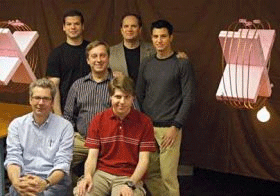Imagine a future in which wireless power transfer is feasible: cell phones, household robots, mp3 players, laptop computers and other portable electronics capable of charging themselves without ever being plugged in, freeing us from that final, ubiquitous power wire. Some of these devices might not even need their bulky batteries to operate.
A team from MIT’s Department of Physics, Department of Electrical Engineering and Computer Science, and Institute for Soldier Nanotechnologies (ISN) has experimentally demonstrated an important step toward accomplishing this vision of the future. The team members are Andre Kurs, Aristeidis Karalis, Robert Moffatt, Prof. Peter Fisher, and Prof. John Joannopoulos (Francis Wright Davis Chair and director of ISN), led by Prof. Marin Soljacic. Realizing their recent theoretical prediction, they were able to light a 60W light bulb from a power source seven feet (more than two meters) away; there was no physical connection between the source and the appliance. The MIT team refers to its concept as “WiTricity” (as in wireless electricity). The work will be reported in the June 7 issue of Science Express, the advance online publication of the journal Science.
The story starts one late night a few years ago, with Soljacic (pronounced Soul-ya-cheech) standing in his pajamas, staring at his cell phone on the kitchen counter. “It was probably the sixth time that month that I was awakened by my cell phone beeping to let me know that I had forgotten to charge it. It occurred to me that it would be so great if the thing took care of its own charging.” To make this possible, one would have to have a way to transmit power wirelessly, so Soljacic started thinking about which physical phenomena could help make this wish a reality.
Various methods of transmitting power wirelessly have been known for centuries. Perhaps the best known example is electromagnetic radiation, such as radio waves. While such radiation is excellent for wireless transmission of information, it is not feasible to use it for power transmission. Since radiation spreads in all directions, a vast majority of power would end up being wasted into free space. One can envision using directed electromagnetic radiation, such as lasers, but this is not very practical and can even be dangerous. It requires an uninterrupted line of sight between the source and the device, as well as a sophisticated tracking mechanism when the device is mobile.
In contrast, WiTricity is based on using coupled resonant objects. Two resonant objects of the same resonant frequency tend to exchange energy efficiently, while interacting weakly with extraneous off-resonant objects. A child on a swing is a good example of this. A swing is a type of mechanical resonance, so only when the child pumps her legs at the natural frequency of the swing is she able to impart substantial energy. Another example involves acoustic resonances: Imagine a room with 100 identical wine glasses, each filled with wine up to a different level, so they all have different resonant frequencies. If an opera singer sings a sufficiently loud single note inside the room, a glass of the corresponding frequency might accumulate sufficient energy to even explode, while not influencing the other glasses. In any system of coupled resonators there often exists a so-called “strongly coupled” regime of operation. If one ensures to operate in that regime in a given system, the energy transfer can be very efficient.

